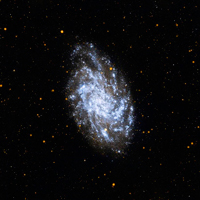Chris Martin
Father of GALEX Nurtures Baby Through 15-year Gestation
Profile by Diane K. Fisher

Its mission to see 80% of the way back to the Big Bang notwithstanding, because GALEX is classified as a NASA Small Explorer mission, you might expect that it was conceived, built, and launched within the span of a few short years. Not so! As its Principal Investigator, Chris Martin, tells the story, it was about 50% of the way back to the Big Bang when he first conceived the idea of doing a UV all-sky survey from space.
It was the late '80s. Martin had just taken his first full-fledged faculty position at Columbia University. His two doctoral dissertations at Berkeley (one would be enough for most candidates) had involved UV instruments boosted above the atmosphere, one by a rocket and one by the space shuttle. Both had been very successful.
"I was lucky," Martin says, modestly.
Now at Columbia, as an assistant professor with his own cadre of graduate students, he had a dream to put UV sensors in space to survey the entire universe. So he assembled a team to pull together a proposal to be one of the first mission set in NASA's new Small Explorer (SMEX) program to study important questions in space physics, astrophysics and upper atmosphere science. Martin engaged a new friend associated with the budding Brazilian Space Agency to partner as the spacecraft contractor. But, alas, before the proposal could come together, a change of leadership in Brazil proved unfavorable to Martin's new friend and their proposed joint project.
Back to the drawing board a few years later, Martin saw an opportunity to partner with the Italian Space Agency in proposing again for the second SMEX mission set. The whole idea was to propose a very ambitious project that still fell within the SMEX budget guidelines for NASA's portion by partnering with another nation to provide the spacecraft. The JUNO (Joint Ultraviolet Nightsky Observatory) proposal was accepted and successfully completed its definition phase. Unfortunately, it did not proceed to flight development due to funding issues with the Italian Space Agency.
About the time JUNO was accepted, Martin attained tenure at Columbia, and also received an offer to join the Caltech faculty. When his JUNO team was able to join him at Caltech, they began building on their JUNO experience to do a really detailed, carefully thought out, yet very ambitious proposal. Some of the proposal's critics thought it was too ambitious and wouldn't work. Others didn't see the value of the data. Still others complained that there would be too much data! However, the proposal won and in October 1997 became part of the third set of SMEX missions.
Initially proposed to launch in 2001, delays due to various unforeseen challenges and plain bad luck pushed the launch out to April 2003. So now, more than 15 years after it was first conceived, the GALEX all-sky UV survey is returning a tidal wave of data and images that far exceed the wildest dreams Martin ever had for the mission.
Martin declares, "All the initial political setbacks, technical challenges, management stress, and hard work are now bearing fruit. I am delighted with the quality of the images. We are discovering all kinds of things and already have the beginnings of about 30 scientific papers."




